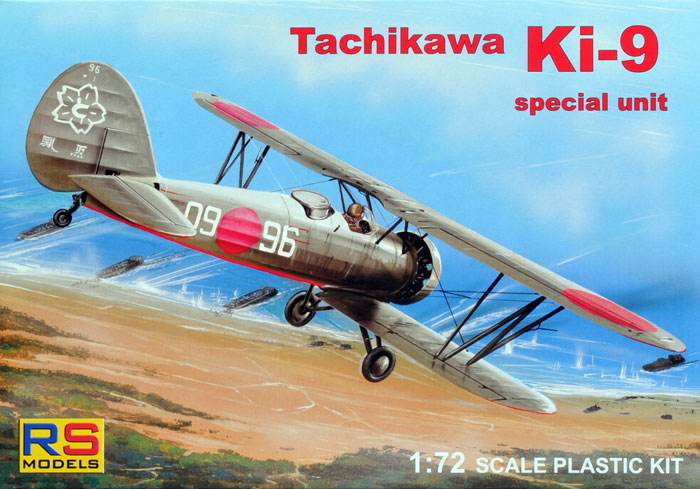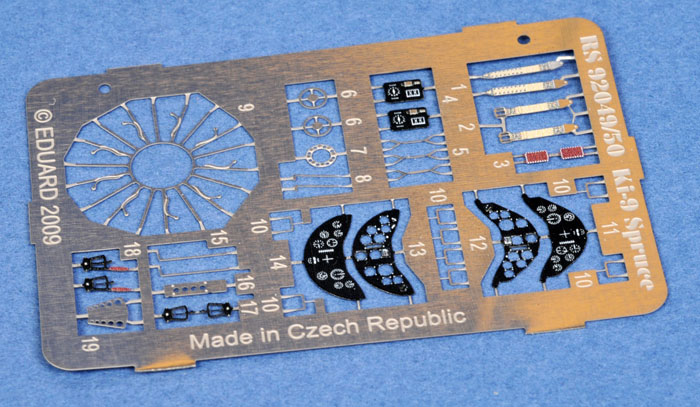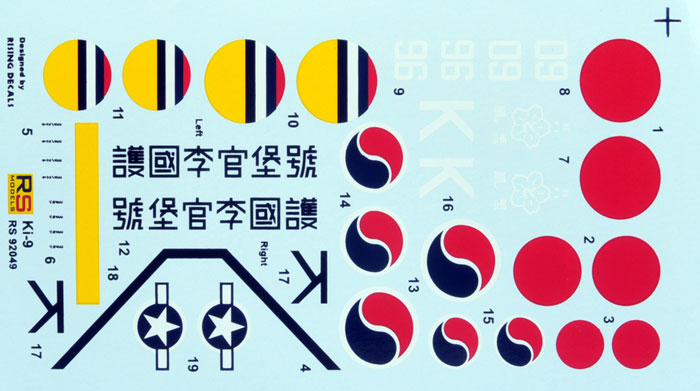Tachikawa Ki 9
Special Unit

RS Models, 1/72 scale
S u m m a r y : |
Catalogue Number: |
RS Models Kit Number 92049 - Tachikawa Ki 9 |
Scale: |
1/72 |
Contents & Media |
40 x tan styrene, 1x Eduard coloured photo-etch fret (28 parts), 2 x clear styrene windshields, and decals for four subjects |
Price: |
Available online from Hannants for £12.43 Modelimex for ?15.35 |
Review Type: |
First Look |
Advantages: |
Superb surface detail, generally simple construction and good detail levels for the scale. |
Disadvantages: |
None worth mentioning. |
Conclusions: |
A good kit of an interesting and attractive subject. |
Reviewed by Mark Davies

HyperScale is proudly supported by Squadron.com
It seems almost every air force of the 1930’s and 40’s had a simple small biplane to provide primary and intermediate pilot training. The Imperial Japanese Army Air Force was no different with its Tachikawa Ki 9. Typical of the type, the Ki 9 was an attractively proportioned plane that first flew in 1934.
Initially the Ki 9, as the Army Type 95-1Model A, had a somewhat complex split-axle undercarriage with wheel fairings. In 1939 this was simplified along with a small change to the fuselage’s length and some weight reduction, all of which improved flight characteristics. This modified version was known as the Model B
Both versions were widely used, and like many other aircraft of this type could be equipped with a blind-flying hood. Perhaps more unusually for the type, there was a version with a clear enclosed rear cockpit for staff officer transportation.
About 2,600 were produced from all sources, and served with several other Asian air forces. These included in WW2 the IJAAF and the air forces of Manchukuo, Thailand, and Nanjing Nationalist Government. Post war users were Indonesia, the Republic of China (Taiwan) and South Korea.
The kit comes in a typically Czech end-opening box with attractive artwork on the front. The box is titled “Tachikawa Ki 9 Special Unit”, and the plane illustrated has what looks like a 44 gallon drum of gasoline in the rear cockpit as it flies over an amphibious landing. So presumably the “special unit” appellation refers to a Kamikaze machine (whilst the box art decals are included, the fuel drum is not).
The instructions provide a parts map, and a fairly easy to follow diagrammatic assembly format. I say fairly easy as each stage of assembly instructions has the part numbers “floating” around the parts illustration, and only in a few cases a line showing where the part attaches. This is adequate in so fart as it identifies the parts used in each stage, but might be better with the part number adjacent to the illustrated part rather than floating at the diagram’s periphery. There is also a brief history of the aircraft. Text is in Czech and English.
Painting and decal guides are printed on glossy coloured paper with colour call-outs using generic colour names and of course an indication of the shade from the colour inks used. This coloured sheet has both the decal schemes offered by this boxing on one side, and another four presumably covered by an alternate boxing on the reverse.
I have several RS Models kits collected over past years. Whilst these have all been good, I was immediately struck by the excellent quality of the moulding in this kit. Not only are the styrene parts cleanly moulded limited-run items, but they have simply excellent surface detail with very restrained but authentic appearance to fabric covered and metal surfaces alike.
Detail parts are finely moulded with plenty of interior detail for the scale. This consists of moulded stringers on the insides of the fuselage halves, separate tubular structure, floor panels, seats and control columns in styrene. This sub-assembly is enhanced by the pre-coloured PE set which provides trim wheels, throttles, seatbelts and what look like radio panels; although these last items are not illustrated in the instructions.
The instructions also show the throttles fitted to the tubular frame on both sides of the cockpit! As the Ki 9 was a primary and intermediate trainer I’d suggest looking at cockpit of an IJAAF fighter and put the throttles on the same side. I checked my copy of Monogram’s Japanese Aircraft Interiors 1940-1945, but the photos of the Ki 9 do not show the throttle. However, a conventional throttle on the left seems a safe bet. As an aside, this reference did show a photo of the box-art subject, and mentioned the intention was to use the Ki 9 in a suicide role with a drum of explosive material in the event of mainland Japan being invaded.

A nicely moulded engine relies on PE pushrods with ignition wires included in the same part. That is to say the 2-dimensional pushrods have a curly piece hanging out to the side halfway up their length to connect to the cylinder head’s spark plug location. It’s nit picking, but I dislike PE pushrods. In this scale integral pushrods are usually quite adequate with cowled radials. I would suggest that if you don’t like flat push rods then make your own from fine rod or stretched sprue. Possibly you could cut the PE rods down and use the PE part purely as an ignition harness. However before I write of PE pushrods altogether, it might be worth seeing if they can be “beefed up” with some coats of Mr Surfacer or similar product. Two exhaust collectors and two stubs, plus a neatly moulded propeller with PE hub boss round the engine.
Construction sequence and parts breakdown is conventional for the type. Various small items like a mirror under the top wing, pitot tubes, PE control actuators, and what looks like a PE flare rack to be fitted to the outside of the cockpit are all provided. The windscreens are clear and sufficiently delicate to be convincing.
The decal options are all quite attractive.

The first is the IJAAF Special Unit plane of the box art, with olive drab with orange undersurfaces and a white outline Chrysanthemum on the tail. The next is a South Korean machine with circular national insignia prior to the adoption of US-style bars, yellow fuselage stripe, and red cowl and rudder. The next is another South Korean machine, coloured the same as previously, but with pre-1948 US stars and bars on the fuselage, and a white outlined black letter K on the rudder. The last, and in my view the most interesting, is an overall orange machine with brown cowl and some olive drab on the fuselage forward of the cabane struts, and also this colour on the undercarriage legs. What sets this last option off are the unusual Manchukuo national insignia and Asian script characters (presumably Japanese) along the length of the fuselage.

The decals appear to be well printed with good opacity, although on my example the registration was ever so slightly out on the Manchukuo roundels because the horizontal coloured lines overlap the circumference of each. A suitable round template and a quick slice through just the decal with sharp knife will fix this before soaking off the backing paper, so no real problem here.
In summary, this is a very nice limited run kit of an attractive 1930s trainer. Japanese subjects are not always the most popular in many markets and non-combat types even less so.
The quality of this kit is such that it deserves to do better than its esoteric subject matter might allow it.
Thanks to RS Models for the sample
Review Text Copyright © 2009 by Mark Davies
Page Created 20 April, 2009
Last updated
20 April, 2009
Back to HyperScale Main Page
Back to Reviews Page |
